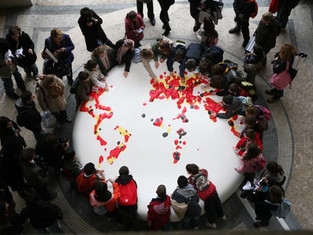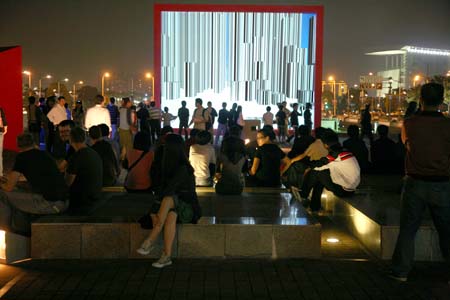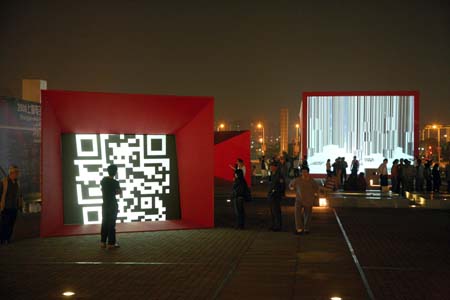Maurice Benayoun’s real-time data art: The Internet is the world's nervous system
- Jan 5, 2016
- 9 min read
Updated: Nov 27, 2024

Maurice Benayoun’s Real Time Data Art Shows the Internet as the Nervous System of the World
Streaming Museum celebrated its fourth anniversary on January 31, 2012, at Big Screen Plaza in New York City, with renowned French artist Maurice Benayoun’s first solo exhibition in the US, and the US premiere of his real-time artworks Emotion Forecast (2010) and Occupy Wall Screens (2011). Also presented were on-the-scene documentaries of the premieres of two public artworks by Benayoun – Still Moving (2008) at le Grand Palais, Paris, and NeORIZON (2008) at the eArts Festival, Shanghai.
The exhibition in video format was on view January 31 to March 31, at Big Screen Plaza (851 Avenue of Americas, NYC) and the real-time version was viewed for two years at streamingmuseum.org.
Emotion Forecast has toured internationally to ZERO1 San Jose Biennial, California; MOMENTUM, Berlin; Big Screen Plaza, NYC; Dubai, UAE; ISEA Sydney 2013, Federation Square, Melbourne, Australia; upcoming locations to be announced. Information below: EMOTION FORECAST OCCUPY WALL SCREENS [Videos] PUBLIC ARTWORKS - Still Moving and NeORIZON [Video] EXCLUSIVE CONVERSATION with Maurice Benayoun in the Financial District, NYC
[Video] OPENING RECEPTION EXHIBITION and LECTURE SCHEDULE
PRESS RELEASE
INTERNATIONAL PRESS
MAURICE BENAYOUN – BIOGRAPHY
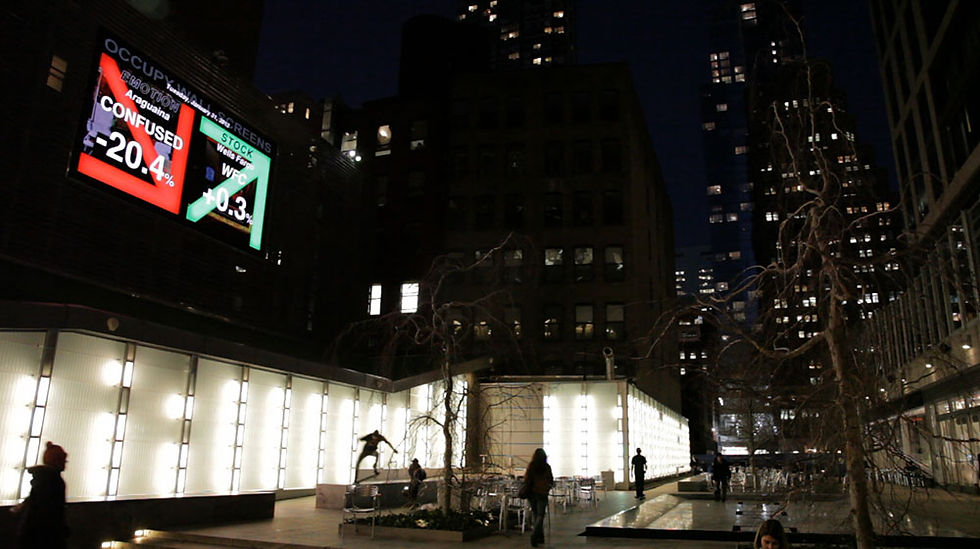
Featured image Emotion Forecast, Paris, by Alexia Guggemos. Image, Big Screen Plaza, NYC, by David Bates, Jr.
EMOTION FORECAST
Emotion Forecast (2010) from Maurice Benayoun’s Mechanics of Emotions series of over 20 works, reflects on the notion of the Internet as the nervous system of the world. It takes data from the Internet that measures 48 emotions on websites related to current events in more than 3200 cities worldwide, researches proximity of emotions and locations, and forecasts the tendencies for the next 2 days. The work embodies a hybrid integration of stock ticker display and the human factor.
OCCUPY WALL SCREENS
still images from real-time artwork




Occupy Wall Screens (2011) from Maurice Benayoun’s Mechanics of Emotions series of over 20 works, reflects on the notion of the Internet as the nervous system of the world. The left side of the piece projects data collected from search engines that maps and assesses the emotional trends of cities active in the OWS movement, and on the right side shows the market trend of financial stocks. 99% down, 1% up!
PUBLIC ART
Maurice Benayoun premiered his interactive public artworks, Still Moving in Paris at le Grand Palais, and NeORIZON at the eArts Festival in Shanghai.
STILL MOVING, 2008, le Grand Palais, Paris
The world premiere of Still Moving, an interactive sculpture, took place at the entrance of one of the largest monuments in Paris – le Grand Palais, during the European City of Sciences event, November 14 to 16, 2008.

Still Moving is an interactive, dynamic, deflated globe sculpture, 3.5m in diameter and 0.9m high, with sound and video projection, that reacts to the analysis of digital data derived from search engines measuring 3 emotions – anxiety, nervousness and excitement, in 3200 of the world’s largest cities.
The sculpture’s infrasonic music (5 to 20 Hz) can only be perceived by the body and is activated when touched. Emotion layers and strata are like tectonics.
Conceived by Maurice Benayoun in the frame of a series of over 15 works on the Mechanics of Emotions, Still Moving is a snapshot of a map of world emotions whose relief is not related to geology, but rather to emotional intensity variations spotted on the internet.
The information conveyed by the search engines, brings a daily system of responses that reflect a sociologic, geographic, and scientific reality. However, this system is affected by a linguistic (English language predominance) and technologic (geographic predominance of industrialized areas) filtering. Which representation of the world can we obtain through the network? Too often considered as the world’s nervous system, the Internet seems to neglect the phantom limbs of the planetary system: for example, Africa, becomes an archipelago, far from the reality of the continent, as an amputated limb, from which you would not even feel the ghost pains.
The Mechanics of Emotions series explores the world affects representation modalities as a global body. This work interrogates the actual limits of the representation system and the new interpretative filtering process.
Still Moving was a Public Commission of the Ministry of Culture Délégation aux Arts Plastiques. The sketches for this piece of art are part of the Contemporary Art National Fund (FNAC). Still Moving has been co-produced and co-presented by Arcadi regional support program of Ile de France.
NeORIZON, 2008, Shanghai
NeORIZON is an urban interactive art installation produced for the Horizon Outdoor exhibit during the eArts Festival Shanghai, October 18 to 22, 2008, curated by Yan Xiaodong.
The city skyline defines the “profile” of the City. It is the visible part of its identity. At the same time, the skyline alters and replaces the horizon line, the limits of the visible world. The city is hiding the horizon by creating a new one. So “human” like! The city is a place built by the people for the people, at the same time it expands and neutralises their individualities.The process of converting everyone’s energy into a city is not a well-known one. Should people be seen as bricks of this edification?
NeORIZON makes this process visible in a symbolic form. The city seems to be invaded by the “IDWorms.” The IDWorms, are crawling on the ground on Century Avenue, Pudong, Shanghai. They invite people to have a look inside, then being converted into 2D (QR)Codes which are an apparently neutral way of identifying people and objects. They all look the same if you don’t know how to decipher them.
On the main screen a city landscape (IDscape) is being built out of the black and white pixels of the personified IDCodes. On the Internet, everyone can get its own 2D code and use it as a personal signature that everybody will recognise by using cell phones as though they were identifying mass consumption products.
In Maurice Benayoun’s work, urban installations are the most visible part of what the artist calls Critical Fusion, introducing fiction into reality to improve its transparency. NeORIZON is one of the works that introduce hints to help and decipher codes of our daily lives into the physical space.
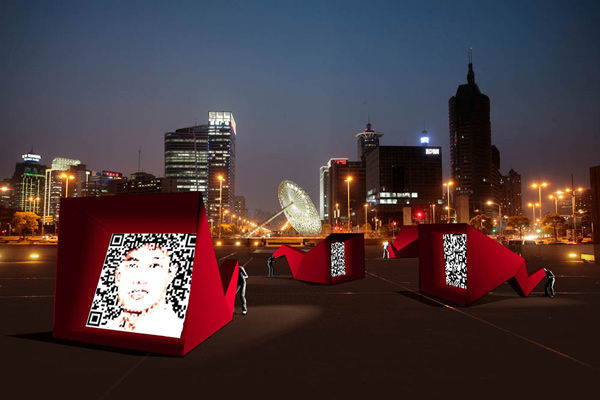


The IDWorms are odd beings that live in the city, showing off their red shape on Century Avenue. Many of them are crawling in the street. Their shape is a geometric volume with a small end – which makes you feel it looks like a mouth, a mouth swallowing visitors identity – and a large end that is made up of a big rear projection screen.
At the small end, at the visitor’s face height, people come to have a look inside. They don’t immediately understand that their face will be converted into a 2Dcode.
At the larger end, a screen displaying giant black and white pixels. Sometime a face (the one coming in front of the small end) shows up that is quickly converted into the surface of black and white dots.
These worms seem to have a job to do: convert people into signs to make them definitely recognisable.
IDCodes
There is no entity, objects, animal or people that will escape from tagging.
What if we are recognised by an QR Code like any object of consumption?
Analysing our image, the IDWorms convert us in Codes that we will be able, after downloading the software on the Internet, to read as the best way to know about the people we meet.
The IDScape
On one side of the place on Century Avenue, Pudong, Shanghai, where the IDWorms crawl, a giant screen, visible from the same angle displays a kind of city landscape that perpetually grows.
At the bottom of the screen, the ground moves away like a long surface of fabric mapped with thousands of ID Codes (2D codes built out of the visitors’ face) representing people captured by the IDWorms. The visitors IDcodes have been converted into the very texture of the city. The one the city will be made of. As the IDcodes are moving away from us like a continuously growing roll of fabric, some of them are extruded from the ground, becoming cubes and volumes, converting the ground surface into a growing number of buildings. People are converted into a city that will never end growing.
Either a sculpture or a processing machine, the IDWorms are doing this very specific filtering that makes an artwork become an enlightening experience talking to the people about people.
The resulting image must give the impression that IDCodes are becoming the skyline of an ever-growing city, hiding the horizon.
INTERVIEW
Maurice Benayoun Occupies the Financial District – A Conversation with Tanya Toft Renowned French media artist Maurice Benayoun converses with Streaming Museum’s Associate Curator, Tanya Toft, as they visit Wall Street, Zuccotti Park, the World Trade Center, Trinity Church and St. Pauls in New York City’s Financial District. [30:00]
OPENING RECEPTION
Streaming Museum celebrated its fourth anniversary with an exhibition by renowned French new media artist Maurice Benayoun at Big Screen Plaza, NYC on January 31, 2012, 6 – 8 PM. Over 125 guests who attended the reception at the Syd Mead designed Bar Basque in the Eventi Hotel (835 Avenue of the Americas), enjoyed dramatic views of the artwork on the Big Screen. Shamina de Gonzaga, Director of World Council of Peoples for the United Nations, gave the toast, and Maurice Benayoun and Streaming Museum Founder, Nina Colosi, greeted guests. The exhibition is permanently on view at streamingmuseum.org and will be exhibited in public spaces in the museum’s global network.
LECTURES

LECTURE: Maurice Benayoun at Columbia University
Presented by Visiting Professor of Composition, Jean-Baptiste Barrière
Date/Time: February 1, 2 – 4 pm
Location: Dodge Hall, Room 803, Columbia University, 2960 Broadway

LECTURE: Maurice Benayoun at Parsons the New School for Design
Media ART Banquet 03 lecture program directed by Dooeun Choi
Date/Time: February 2, 8 – 10 pm
Location: 6 East 16th Street, Room 10009
PRESS RELEASE
Photographs by Alexia Guggémos
French Pioneer New Media Artist Maurice Benayoun Forecasts World’s Emotions at Streaming Museum’s Fourth Anniversary Celebration at Big Screen Plaza, NYC
New York, NY — Streaming Museum, an international public art and online museum, will celebrate its fourth anniversary on January 31 with the US premiere of “Emotion Forecast” and “Occupy Wall Screens,” real-time artworks by the renowned French artist Maurice Benayoun. The exhibition will be on view for two months at Big Screen Plaza in New York City and as a permanent installation at StreamingMuseum.org.
The opening reception will take place from 6 to 8 pm on January 31 at the Eventi Hotel’s Bar Basque, designed by futurist Syd Mead (839 Avenue of the Americas). Guests will enjoy dramatic views of the exhibition on the big screen in the presence of Benayoun who will also give a lecture at Columbia University and Parsons the New School for Design.
“Emotion Forecast” and “Occupy Wall Screens” are part of Maurice Benayoun’s ongoing series on the “Mechanics of Emotions” which translate emotions into maps, performances, the Emotion Vending Machine, and sculpture relics of the world.
Using a system similar to the one employed in weather forecasting to measure the movement of clouds, “Mechanics of Emotion” applies data collected from search engines to map and assess emotional trends. For example, “Occupy Wall Screens” compares the emotional trends of cities active in the OWS movement to the market trend of financial stocks. 99% down, 1% up!
Benayoun wonders, “what would happen if economy and trade were based on the emotional state of the planet,” asking, “Shouldn’t we follow changes, major mood swings, trouble spikes of human moods as we do the weather forecast and the stock market?” Through the “Mechanics of Emotion” art series, Benayoun explores that idea, displaying and anticipating the emotional state of the world as it undergoes major upheavals and predicting how the market will respond. In other words, he has created a prediction service of emotional statistics.
Nina Colosi, Founder of Streaming Museum is “delighted to have the opportunity to present the first US solo exhibition of Maurice Benayoun whose social commentary and groundbreaking use of technology and the internet are relevant to the focus of Streaming Museum.”
Maurice Benayoun, born in 1957 in Mascara, Algeria, is a pioneer new-media artist and theorist based in Paris. His art employs various media, including and often combining video, immersive virtual reality, the Web, wireless technology, performance, large-scale urban art installations and interactive exhibitions. Benayoun’s work has been exhibited worldwide and he has received numerous international awards and prizes, including the coveted Ars Electronica Golden Nica. He is co-founder and art director of the CITU research center (Création Interactive Transdisciplinaire Universitaire), and H2H Lab (Human to Human Lab), Paris 1 Pantheon Sorbonne and Paris 8 Universities, dedicated to research and creation in the emerging forms of art.
The artworks have been developed by Robin Gareus, at the CiTu-Paragraphe Lab of Paris 8 University, in the frame of The Art Collider project as a part of the PUF program of the FACE Foundation in collaboration with the SFAI (San Francisco Art Institute). Benayoun.com
Streaming Museum is the first global public space and online hybrid museum with collaborating locations and cultural centers on 7 continents.
The Big Screen Plaza is a creative initiative to promote art, culture and entertainment in a public venue. BSP seeks out creative content from non-web based sources in order to bring fresh thoughts and visuals to our audience. The goal of BSP is to continuously aggregate content to our outdoor LED screen while also establishing a network of portals where content may be viewed. BSP is built upon shared experiences. The 30 x 16.5 ft. HD format screen is located at 29th Street and 6th Avenue, adjacent to the Eventi Hotel. For more information visit bigscreenplaza.com.
PRESS
Can You Dig/It? Taking the Dump of Maurice Benayoun by Timothy Murray
Maurice Benayoun: l’art multimédia pur changer le monde by Daphnée Denis for RSLN (Regards Sur Le Numérique) MICROSOFT
Occupy Wall Screens by Alana Esposito for Artlog 2/10/12
Occupy Wall Screen: A Renowned French Media Artist Takes On Wall Street (VIDEO) by Michael Kurcfeld for Huffington Post 1/30/12
Critical Fusion: Interview with Maurice Benayoun by Lorenzo Taiuti for Digicult.it – Digimag
Without Bounds by Barbara Robertson for Computer Graphics World
Emotion Forecast by Lara Sedbon
Maurice Benayoun: Et si internet était le système nerveux du monde? by Denis-Quentin Bruet for SiliconManiacs.org
BIOGRAPHY
Maurice Benayoun (aka MoBen) (b. 29 March 1957 in Mascara, Algeria) is a French pioneer new-media artist and theorist based in Paris. His work employs various media, including (and often combining) video, immersive virtual reality, the Web, wireless technology, performance, large-scale urban art installations and interactive exhibitions.





